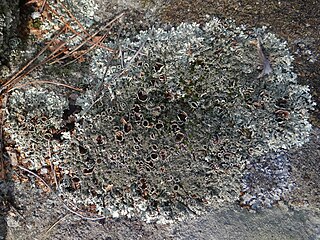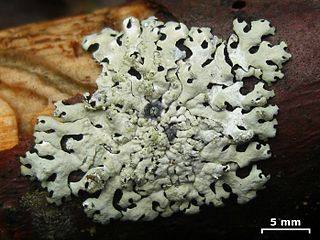
Parmelia is a genus of medium to large foliose lichens. It has a global distribution, extending from the Arctic to the Antarctic continent but concentrated in temperate regions. There are about 40 species in Parmelia. In recent decades, the once large genus Parmelia has been divided into a number of smaller genera according to thallus morphology and phylogenetic relatedness.

The Parmeliaceae is a large and diverse family of Lecanoromycetes. With over 2700 species in 71 genera, it is the largest family of lichen-forming fungi. The most speciose genera in the family are the well-known groups: Xanthoparmelia, Usnea, Parmotrema, and Hypotrachyna.

Punctelia is a genus of foliose lichens belonging to the large family Parmeliaceae. The genus, which contains about 50 species, was segregated from genus Parmelia in 1982. Characteristics that define Punctelia include the presence of hook-like to thread-like conidia, simple rhizines, and point-like pseudocyphellae. It is this last feature that is alluded to in the vernacular names speckled shield lichens or speckleback lichens.

Xanthoparmelia is a genus of foliose lichen in the family Parmeliaceae. Xanthoparmelia is synonymous with Almbornia, Neofuscelia, Chondropsis, Namakwa, Paraparmelia, and Xanthomaculina. This genus of lichen is commonly found in the United States, as well as Australia, New Zealand and Ecuador.
Psiloparmelia is a genus of lichen belonging to the family Parmeliaceae. It contains 13 Southern Hemisphere species, most of which are found growing on rocks at high elevations in South America. There are several characteristic features of the genus that are used to distinguish it from the morphologically similar genera, such as Arctoparmelia, Flavoparmelia, and Xanthoparmelia. These include a dark, velvety lower thallus surface that usually lacks rhizines, a negative test for lichenan, and a high concentration of usnic acid and atranorin in the cortex.

Xanthoparmelia mougeotii is a species of foliose lichen belonging to the family Parmeliaceae.

Xanthoparmelia conspersa, commonly known as the peppered rock-shield, is a foliose lichen and the type species of genus Xanthoparmelia. It is widely distributed in temperate zones, and has been recorded from Japan, Europe, Africa, North America, and South America.

Xanthoparmelia mexicana, commonly known as the salted rock-shield, is a foliose lichen in the family Parmeliaceae. It grows in 4–10 cm diameter rosettes of gray-green to yellow-green lobes in arid climates all over the world.
Arctoparmelia separata, commonly known as the rippled ring lichen, is a species of foliose, ring lichen in the family Parmeliaceae with a roughly circumpolar distribution.

Xanthoparmelia lineola, commonly known as the tight rock-shield, is a foliose lichen species in the genus Xanthoparmelia. It is a common species with a temperate distribution. Found in North America and South Africa, it grows on rocks.
Bulbothrix meizospora is a species of foliose lichen in the family Parmeliaceae. It is found in Africa, Asia, and South America, where it grows on tree bark.
Xanthoparmelia serusiauxii is a species of foliose lichen in the family Parmeliaceae. Found in Namibia, it was formally described as a new species in 1986 by American lichenologist Mason Hale. The type specimen was collected by Hale from the Laguneberg Mountains, southeast of Cape Cross. There, it is common on dolerite boulders and small, flat pebbles. The specific epithet honours Emmanuël Sérusiaux, who, according to Hale, "was the first lichenologist to collect this unusual lichen in Namibia".
Flavopunctelia praesignis is a species of foliose lichen in the family Parmeliaceae. It was first described as Parmelia praesignis by Finnish botanist William Nylander in 1872. In 1982, Hildur Krog transferred it to the subgenus Flavopunctelia of her newly circumscribed genus Punctelia, created to contain Parmelia species with punctate (point-like) pseudocyphellae. Mason Hale raised this subgenus to generic status a couple of years later. The lichen is colloquially known as the fruiting speckled greenshield. It is found in the southern United States, in various states of Mexico, and in South America. It has also been reported from Kenya, but that may be due to misidentification.

Punctelia perreticulata is a widely distributed species of foliose lichen in the family Parmeliaceae. It occurs in Mediterranean Europe and Russia, North America, South America, Australia, and New Zealand, where it grows on rocks, bark, or wood. Its main distinguishing features are its thallus surface, marked with many shallow depressions, grooves, or pits, and sorediate pseudocyphellae. The lower side of the thallus is ivory to tan towards the centre and the major secondary metabolite in the medulla is lecanoric acid. A lookalike species with which it has been historically confused is Punctelia subrudecta; this lichen can be distinguished from Punctelia perreticulata by the texture of the thallus surface, or, more reliably, by the length of its conidia.
Xanthoparmelia kalbii is a species of foliose lichen in the family Parmeliaceae. Found in Brazil, it was described as a species new to science in 1984 by American lichenologist Mason E. Hale. The type was collected in Catimbau National Park in Pernambuco. The specific epithet honours Klaus Kalb, "the first professional lichenologist to collect extensively in Brazil since G. A. Malme in the 1890s".
Punctelia subflava is a species of foliose lichen in the family Parmeliaceae that occurs in Australia.

Parmelina quercina is a species of foliose lichen in the large family Parmeliaceae. It is found in continental Europe.

Hypotrachyna osseoalba, commonly known as the grainy loop lichen, is a species of foliose lichen in the family Parmeliaceae. It is widely distributed in subtropical and temperate areas of the world. Characteristic features of the lichen include the pustules in its cortex, the somewhat linear shape of the lobes comprising the thallus, and the branched rhizines.
Xanthoparmelia annexa is a foliose lichen species in the family Parmeliaceae. It was first formally described as a new species in 1964 by Japan lichenologist Syo Kurokawa. After being transferred to genus Paraparmelia in 1986, John Elix transferred it to the genus Xanthoparmelia in 2003 after the two genera were deemed to be synonymous.
Xanthoparmelia camtschadalis is a foliose lichen that belongs to the genus Xanthoparmelia. The lichen is also known as the Kamchatka rock-shield lichen. The lichen was formally described as a new species in 1974 by American lichenologist Mason Hale.











